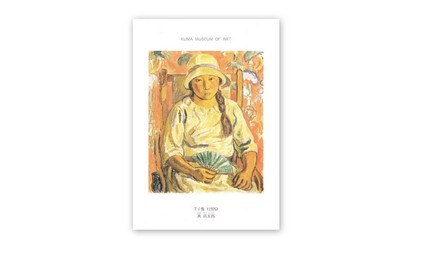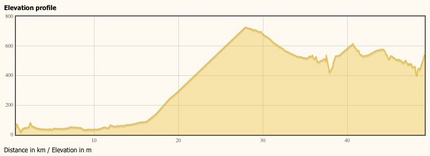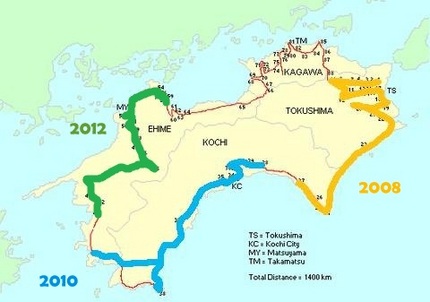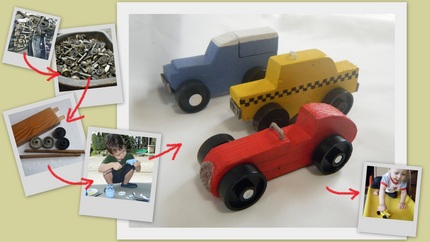I love old Landcruisers like this one. In outback (countryside) Australia, you can still see quite a lot of them, especially the tray-back version. That version is popular because it`s useful for carrying farm things such as tools, animal food, and working dogs. And because farmers in outback Australia are good at repairing & maintaining machines, they are able to keep old cars running for many years.
I saw this blue one not far from my house. Cool isn`t it? It`s a little rusty, but I think that actually suits it.
The owner of this car is lucky - just driving to work would feel like an adventure.
Oven cooking is often troublesome & time-consuming, but scones are quick & easy to make, & don`t need many ingredients. They taste good with jam & butter or cream, along with a nice hot cup of tea - yum.
Ingredients:
- 300g (2 cups) Plain flour
- 10g (4 teaspoons) Baking Powder
- 30g Butter
- 180ml (3/4 cup) Milk
Method:
- Mix flour & baking powder
- rub butter into flour with your fingers
- Add milk, mix
- cut or roll into pieces/balls
- cook in oven at 220deg. for 15-20mins.
Good luck!
While doing Shikoku henro, we spent one night in a small town called Kuma. There was a small art gallery there, which we had just enough time to visit. Unfortunately they were holding an exhibition of strange modern photography instead of their usual collection, so I could only see it on their postcards... This is one I bought.
If you visit Kuma, I recommend visiting the Kuma Museum of Art. The curator is very nice, and if you ask (as my father-in-law did while I wasn`t looking), she`ll even book you a room for the night in town! What a kind lady.
We spent the night in a town called Imabari, woke up early the next morning, and headed off to temple number 54. We arrived well before opening time - 8am - but the priest kindly opened early and stamped my father-in-law`s book. Temples 54 - 59 were quite close, and only one was a little up a mountain, so we managed to visit them all before noon. Another reason we could visit them quickly was that, unlike usual, we didn`t get lost along the way. Getting lost is frustrating, but also kind of interesting I think, if you`re not in a hurry to get somewhere.
Anyway, we caught the train about midday & headed back to Ichinomiya. Along the way, the train followed the north coast of Shikoku Island for a while - the view was great. I felt happy & satisfied.
I`m looking forward to returning to Shikoku to complete my `henro`, maybe next year.
In some of my photos you can see people wearing white clothes & conical (= cone shape) hats. This is the traditional dress for pilgrims [gyouja]. Because I was cycling, I didn`t wear them, & I couldn`t carry a walking staff [kongoutsue] either. That`s kind of a shame, because they`re very ornate & colorful, & I`d quite like to have one. Maybe next time I`ll buy one as a souvenir.
Actually, most henro pilgrims don`t use their staffs for walking - I often see groups arrive by bus or mini-van, & just before they get off the bus, they get their staffs & conical hats, then they walk from the carpark into the temple. Nowadays not many people do the full henro on foot (it takes one or two months to complete).
While trying to find out how high henro temple number 45 (Iwaya-ji) was, I found this interesting GPS graph. It was posted online by someone who cycled the same route. I think the beginning point is Matsuyama, & the final point is Iwaya-ji.
I feel tired just looking at it.
Day 2 was the toughest day of our trip - we had to climb a big mountain. Sometimes we rode, sometimes we walked, and sometimes I just sat down by the side of the road, ate a mandarin [mikan] (Ehime prefecture is famous for mandarins) and cried for a while. It was hard work.
But coming down the other side was fun.
As you can see, the leaves have started changing colour in some places.
We were on Shikoku for four days altogether. These are some photos from the first day. If you have any questions, please ask me in Comments. For example:
- What kind of flowers are those in the second picture? A: They`re cosmos.
- What kind of crab is that? A: Sorry, I don`t know. I saw a few of them on one mountain road we were on.
- How big was it? A: About 7cm across.
- Did you pick it up? A: Yes.
- Did you keep it? A: No.
- Did you cook it & eat it? A: No!
Click on the picture to enlarge.
During our school`s autumn holiday, my father-in-law & I took our bicycles to Shikoku Island to continue our cycling tour of the island`s 88 `henro` temples. As you can see from this map, we completed about a quarter in 2008, another quarter in 2010, & this time we managed about the same.
The weather was good, & we didn`t have too many problems. Of course I took a lot of photos - I`ll post some of them over the next day or two.
My father-in-law has lots of old machine spare parts. I saw some plastic wheels in a bucket & thought they would be good as toy car wheels. Of course I used recycled wood for the bodies. So far I`ve made 3 cars, & I hope to make more in the future. It was interesting to research & design the shapes.
The designs are based on the following:
- 1950s F1 Ferrari
- 1970s/80s New York taxi
- 1960s Landrover
Which one do you like the most? What do you think I should make next?
- ブログルメンバーの方は下記のページからログインをお願いいたします。
ログイン
- まだブログルのメンバーでない方は下記のページから登録をお願いいたします。
新規ユーザー登録へ










